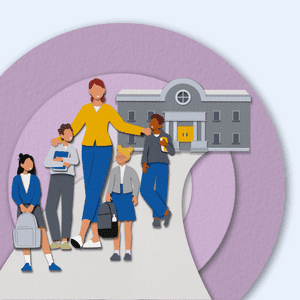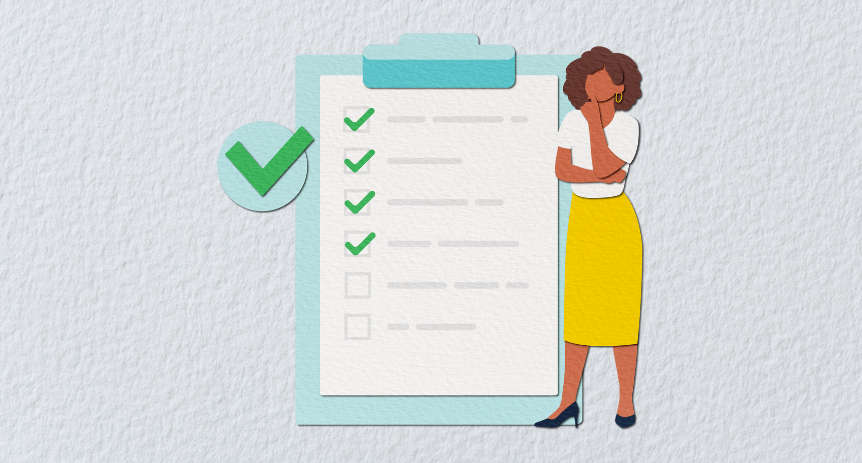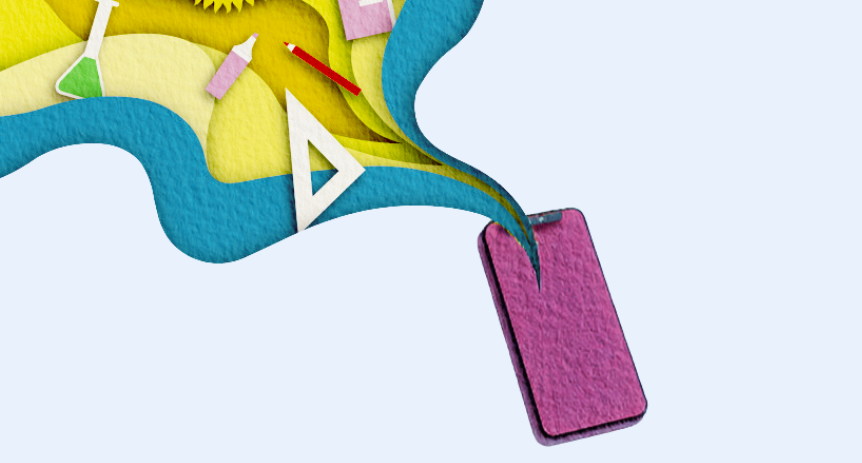The job of a substitute teacher is an important one. When full-time teachers are absent, it’s up to you to take the lead and keep students on track.
Teachers may leave you scant or no lesson plans, students may be unhelpful in getting you oriented to their classroom, and each day may bring new surprises. Since you can’t anticipate the unknown, being as prepared as possible will help you be confident in your ability to think on your feet.
Here are some tips on how to get ready for a new classroom.
Talk to the school staff
The staff at the school you’re headed to are your number one resource for making a smooth transition to a new school.
1. Other teachers at the school
Don’t be shy — connect with other teachers at each school you visit. Not only can they help you with any info or questions you need answered, but they can also be great connections for growing your career.
Get to school a bit on the early side and try to meet with the other teachers for your grade level. Ask them for the inside school: for example, if the school has any specific “call and responses,” if there’s a standard behavior management system in place, or if you could send a student who is extra trouble to their classroom.
2. The teacher you’re subbing for
If possible, email or call the teacher that you’re subbing for. They’re the expert on their classroom, academic expectations, potential problem areas, and more. If you can, go over the lesson plans with the teacher ahead of time so you can cover any questions you may have. It may be helpful to keep a regularly updated list of questions you always go over with the teachers so you make the most of your meetings with them.
3. The school principal
The head honcho at the school you’re visiting can give you the lay of the land. Though they may be busy or hard to pin down, be persistent about introducing yourself to them. Especially if the teacher you’re subbing for is unavailable, the principal can provide a wealth of info to make your days more successful.
4. Other school staff
The administrators, cleaning staff, and security team can also be a great resource for you. Make sure you introduce yourself to them and ask if there’s anything you need to know about schedule changes, school rules, security protocols, etc.
Gather school resources
Get your hands on as many resources about the school you’re attending as you can.
5. The student handbook and agenda book
Let’s face it, students aren’t always your best sources of information about the rules and traditions of their school. Get ahold of the student handbook so you have info on weekly schedules, expectations, school culture, and more.
6. The safety and emergency guidelines
See if there’s a set of guidelines for the staff of the school. This can help you familiarize yourself with the school’s evacuation plan, how to proceed in an emergency, and other crucial information.
If a school doesn’t have any guidelines for subs, be sure to ask other teachers or the administration for information on safety protocols, emergency procedures, and staff contact information.
7. Campus map
If a school has a large or uniquely laid out campus, a campus map can save you a lot of time. If one isn’t available, chat with staff about any aspects of the school layout that might be confusing to newcomers.
Bring just-in-case supplies
Though your school should be stocked with the essentials, it’s a good idea to have your own just-in-case supplies that can make your job a bit easier (SOS lesson plan resources below!).
8. Teacher report forms
To keep the teacher up-to-date on what went on each day, bring some teacher report forms. You may want to create your own, tailored to your needs — or you can use these templates:

9. Seating charts
Seating charts can help you remember your students’ names and preserve order in the classroom. You’ll likely want to tailor your chart to the layout of the classroom, but here are a few templates for inspiration:
10. Folders for student work
You may be carrying stacks of assignments home for grading or need to organize your in-school grading by subject, class, or student.
11. Whistle
It may be hard to get the kids’ attention on the playground, at recess, or even in the classroom if they aren’t familiar with you or queued to pay attention to your voice. A whistle can be a great way to flag your class down.
12. Hand sanitizer
Kids aren’t notorious for being germ-free. Bring hand sanitizer to help you make sure you don’t get sick.
13. Stickers
Stickers are great both for art time and for little rewards throughout the day.
14. Extra school supplies
Your school will have the basics, so this isn’t required. But if you have your own cache of special school supplies, such as scented markers or erasable pens, they could be a fun, engaging addition to the classroom.
- Pens, pencils, markers, crayons
- Dry erase markers
- Chalk
- Blackboard/whiteboard erasers
Get to know the students — and let them get to know you!
To show students you are interested in them and want to learn a bit about them, engage in some fun introductory games, assignments, or art projects.
15. Name tags
You can make your own name tags once you get the class roster.
Or you can simply provide blank labels and let the kids express themselves with their own name tag design.
16. Name posters
Have the students work in groups to create posters with all their names on them. They can even include little facts about their favorite things, what they want to be when they grow up, or their favorite subject. You can hang these up in the classroom in a place where you can easily refer to it. As a bonus for you, you can have them create posters that mirror the seating chart.
17. People poems
Have students create acrostic poems that let you know a bit about them. This is also a good exercise in self-expression.
18. Name chain
Name chains are fun and put students’ memory to the test. Here’s how to play:
- Give the students an example of what to do:
- Say your name
- Say a food that starts with the same letter as your name (or a place, a hobby, a state, etc.).
- The student after you will say what you said (“This is Susan and she likes Slurpees”), and then they will say their name and a food that starts with the first letter of their name.
- Go around the circle, with each student reciting the names and foods of those who went before them in the circle.
19. Clapping names
Or, if you want something simple, just have the class clap out the syllables of each student’s name.
Have the class play some icebreakers
Unless you’re subbing at the very beginning of the year, it’s likely the class will already know each other. But that doesn’t mean you can’t play some fun icebreakers together. The students can learn more about their classmates and about you. Icebreakers are also a fun time to set clear expectations and model good behavior throughout the activities.
20. Two truths and a lie
Have students share three statements about themselves: two that are true and one that isn’t. Have the class guess which statement is made up; this is a good way for you to get to know individual students and class dynamics as a whole.
21. Great winds blow
Great Wind Blows is a simple and fun game, a bit like musical chairs. One person starts in the middle of the circle and says “Great wind blows for everyone who ______________.” They’ll name some characteristic, such as: has ridden a horse. Everyone who has ridden a horse must quickly stand and find a new seat more than 2 seats away from them. The last player left standing is the new person in the middle.
- Great wind blows for everyone who is allergic to peanuts.
- Great wind blows for everyone who loves math.
- Great wind blows for everyone who has a sibling.
- Great wind blows for everyone who has traveled out of the country.
- Great wind blows for everyone who has a dog.
Assign autobiographical work
22. Self-portraits
For younger grades (i.e. K-2), you can have them draw self-portraits and tell you a bit about them. You can hang them up in the classrooms too — this assignment is a parent favorite!
23. Autobiographical writing
For older elementary students up to high school, you can do an autobiography assignment that requires a bit more writing. A great way for you to get to know your students — and for them to get to know themselves a bit better, too!
24. Picture pairs
For younger students, try picture pairs.
- Pair students up and give the students blank paper and crayons.
- Have students take turns sharing five special facts about each other.
- Each student then draws pictures of the five special facts — without writing words.
25. Profiles
For older students, you can have them interview each other. They can ask each other open-ended questions about their lives and write up a brief profile. This helps you (and them) get to know one another while working on their writing skills!
Keep them busy throughout the day
You’ll likely run into times in your classroom when you need an emergency activity to take up some time. This may happen if your teacher doesn’t leave you lesson plans or if the lesson plan takes less time than anticipated.
Here’s a smorgasbord of plug-and-play assignment ideas that don’t require a lot of foundational knowledge, games that are fun for a wide variety of ages, and activities that can further learning.

26. Writing exercises
Come to class with a list of writing prompts for kids to choose from.
27. Sudoku
To keep the class’s math skills sharp, you can print out these math puzzles by difficulty level, so they can be fun for a variety of ages and skill levels.
28. Collage boards
Bring in old magazines and have the students create large collage boards that are relevant to topics you’re studying. They can present their collages to the class, or you can hang them gallery-style for everyone to enjoy.
29. Drawing pictures
Give them some crayons, markers, and paper and let their imagination run wild.
For some sub-specific artwork, check out this great picture-drawing template for younger grades, which prompts students to guess where their teacher might be. As a bonus, the drawings can make a fun gift for when the teacher returns — and give them something to talk about with their class!!
30. Crosswords and word searches
Word searches are great for all ages, especially younger kids, and crosswords are fun for older grades. You can tie both to their current lessons, create a thematic list of words for them to explore — or you can even have them create their own!
31. Coloring pages
Another great activity for younger kids. You can go around the room and ask them to tell a story about the picture they are coloring.
Check out this bank of printable coloring pages.
Tackle a class activity together
32. Performing a skit
The possibilities for topics are endless. Students can:
- Write and perform a rap about a math topic they’re learning
- Host a news show in which they discuss current events, either in the world, in their town, or in their school
- Act out a scene from a book they’re reading
- Create an infomercial pitching a product relevant to a history lesson
- Perform as their favorite tv or movie characters explaining a recent science experiment
If phones are allowed in your school or if there’s audio-visual equipment available, you can also have the students create short videos of their performances.
33. Holding a spelling bee
Hold a spelling bee for the class’s recent vocabulary words. Some students or school admins could even serve as the judges. Have prizes ready for the winners.
34. Solving puzzles and riddles
Brain teasers are a fun activity that you can put on the overhead or read aloud and solve together.
Read a book
35. Read-aloud books
Reading aloud together is a great way to calm down a rambunctious class. You can either read to them or go around the classroom and take turns reading together. Here’s a list of the 100 best read-aloud books.
36. Sub-related books
If your class is struggling with having a sub or you want a way to help kids talk about having a sub, these sub-themed books might be just the ticket.
Play a group game
37. Trivia
You can set up a rousing game of jeopardy or divide the class into teams to face off on general trivia questions.
38. Computer games
Online interactive resources can be fun and educational, but they can also keep the class separated on their little individual screens. By tapping free online sites like Kahoot or Quizalize, the entire class can play valuable online games together.
39. 20 Questions
The guessing game 20 questions is a simple way to reinforce learning or just have some fun.
- You can pretend to be a person from their history lesson, an animal they’re learning about in science, or any other person or concept they’re learning about.
- They ask you 20 yes or no questions and try to guess who you are.
- Students can also take turns being in the hot seat.
40. Heads up
Heads up (available for download on iPhone or Android) is a fun guessing game app with kid-specific decks.
- You put your phone on your forehead and words appear.
- Your students shout out clues — without saying the words on the screen — until you can guess what’s on your forehead.
- Then you move onto the next one.
- You try to see how many you can guess in one minute.
41. Heads up 7-up
Heads up is a good game for quieting kids down a bit.
- Seven students come to the front of the classroom.
- The rest of the students put their heads down on their desk and their thumbs up.
- The seven students quietly move around the room and put down seven thumbs.
- The students try to guess who picked them and if they get correctly, they get to take the place of the person who picked them.
42. Telephone
Telephone is a fun game that illustrates how gossip or not listening well can lead to misunderstandings or falsehoods.
- The class sits in a circle and one person whispers a phrase to the person next to them.
- The phrase goes around the circle, from person to person, until the final person says what they heard.
- Hilarity ensues when the first person says their original phrase.
43. Silent ball
Silent ball is a great quiet game that also lets kids burn off some energy. This is especially good for rainy days or other days when they may not get as much playtime as usual.
- Students stand around in a circle.
- The leader starts by passing the ball to someone else.
- Players sit out if they:
- Miss a pass
- Make a bad pass
- Make a sound
- The final person standing gets to start the next round (or can win a prize).
44. MadLibs
MadLibs are a funny word game you can play with the whole class to create nonsensical stories. They also reinforce grammar studies, as kids have to think on their feet about different parts of speech and name nouns, verbs, adjectives, etc. If you don’t have the MadLib books, you can print out your own.
45. Reviewsical chairs
This game is like musical chairs but it incorporates review of material you are teaching in the class.
- Place student chairs in a circle and remove one chair.
- Have students walk around the room.
- When you say “STOP!” (or you can play and stop music), the students must sit in the remaining chairs.
- The standing student can challenge one of the other students.
- In the challenge, you ask a review question. The first student to answer correctly wins the round.
- Consider prizes for the last students sitting.
Play a board game
Break the class into small groups and have them play board games. Even if you just do it for 20 minutes or so, it can be a nice way to transition between lessons or fill a parcel of time at the end of the day.
46. Apples to Apples
Apples to Apples is a great conversation starter that challenges kids to think on their feet. Students are challenged to come up with quick connections by playing cards that are related in some way to the judge’s card.
If you don’t have the game, you can print out your own cards.
47. Pictionary
Pictionary is like charades, but instead of acting out scenes, players draw pictures and their team members try to guess what they’re drawing.
If you don’t have the game, you can print out your own lists of words.
48. Boggle
Boggle is a great vocabulary game that asks players to find as many words as possible in an array of letters.
If you don’t have the game, you can create your own Boggle bulletin board.
49. Scattergories
Scattergories is a creative thinking game that challenges players to think of as many things in a certain category as possible. The more creative the answers, the more points each player gets.
If you don’t have the game, you can use a Scattergories list generator.
Get control of the classroom
You know that a lot of your job as a sub is getting the classroom under control. Even the most well-behaved classes can get out of hand from time to time. So, here’s a collection of tips and resources you can add to your classroom management toolkit.
50. Rules poster
It may be good to bring a rules poster and go over it with them so everyone has a clear understanding of your expectations.
You’ll likely want to create your own rules poster based on how you’d like to run your classroom, but here are some samples to draw from.
51. Narrate the positive
Instead of calling attention to bad behavior, use positive narration to constantly point out the students who are doing what they are supposed to do. This doesn’t mean focusing on the exceptional students or on the kids that are going above and beyond. Instead, you can help students hear your expectations again and again by simply calling attention to other students who are modeling correct behavior by giving these students positive praise.
52. Enforceable expectations
According to experienced teacher and education thought leader Angela Watson, a great way to communicate your expectations to students is to use firm, enforceable “I” statements, such as:
- “I listen to one student at a time.”
- “I call on students who raise their hand.”
- “I teach when I have your attention.”
- “I take quiet classes to recess.”
Use attention grabbers
Attention grabbers are sounds or call and responses that help you bring the class to order, collect them after free periods or recess, or quiet them down if they’ve gotten rambunctious. Here are some ideas for tried and true attention grabbers.
53. Wind chimes
Bring wind chimes or a bell with you to class and ring it whenever you need the class to settle down.
54. Alarm clock or sound effect app
Download a free alarm clock app or funny sounds app and teach the kids that when you play a certain sound, it means stop talking and eyes to the front.
55. Clapping answers
You call out a math problem, such as 2 + 2 or 8 ÷ 4 and have the students clap back the answer to you.
56. Call and response
Use these call and responses to calm a noisy classroom and get your students’ attention.
- Teacher: “Who’s the friend who likes to play?”
Students: “Bing Bong, Bing Bong!” [from Disney’s Inside Out]
57. Countdown
Simply countdown from 5 or 10.
Keep mischievous students busy
You’ll likely be able to identify students who like to test the limits pretty quickly. Here are some ideas on how to diffuse their mischief-making.
58. Job assignments
Whenever students get loud, distracted, or seem to have too much time on their hands, put them to work! Have a list of jobs on hand that you can dole out or give every student their own permanent job.
Here are some ideas:
- Wash the blackboard
- Clap out the erasers outside
- Feed the class pet
- Water plants
- Straighten up the reading or craft areas
- Pass out papers
- Collect papers
- Pass out supplies
- Take attendance
- Pick up stuff off the floor
- Make copies
- Hall monitoring
- Run errands
- Help peers with homework
59. Brief research questions
Keep open research questions on the board. Whenever a student is idle or making trouble, you can direct them to the research questions. If a student is never “finished” with their work, they can’t have time for disruptions!
Here are some examples:
- How are black holes formed?
- Who discovered how long a light year is?
- Why do humans need sleep?
- How did Martin Luther King, Jr. change the course of history?
- What are three of Thomas Edison’s inventions?
- How do bats navigate?
- How does a tadpole become a frog?
- What are the moons of Jupiter?
- How do the rings of Saturn form?
- What do butterflies eat?
- What colors do dogs see?
- What is a Fibonacci number?
- What is tetrachromatic vision?
- What is Dr. Tin Liu famous for inventing?
Have a reward system
Coming to your classes with a reward system can really motivate your students. You can either use a point system to earn larger rewards or just dole out small rewards for correct answers or good behavior.
60. Prizes
Everyone loves prizes! Here are some fun ideas:
- Stickers
- Small toys
- Bubbles
- Pencils, pens, and other school supplies
- App or music downloads
- Small gift cards
- Edible treats, candy, or gum (tread lightly here — clear treats with the school and check to make sure you’re aware of any allergies)
61. Privileges
Instead of prizes, you can give privileges away for good behavior, acing a review, or winning games. Here are some examples:
- Skip one small homework assignment
- Credit for one missed question on a quiz of your choice
- Pizza party for a group or for the whole class
- Pick the class’s fun activity
- Pick the class’s learning activity
- Select a friend to be your study buddy for the period
Check out more resources
62. How to Be a Great Substitute Teacher YouTube Channel
63. Substitute Survival: Tools You Can Use
64. 50 Ideas, Tips, & Tricks for Every Grade Level
65. Emergency Sub Lesson Plans
66. Interactive Student Activities
67. 80 Sponge Activities
68. 27 Ideas for Students Who Finish Their Work Early
69. 40 Fun Attention Getters
70. When Students Won’t Stop Talking
71. Free Online Personal Finance Games for the Classroom
72. 100 Free and Unique Rewards for the Classroom








